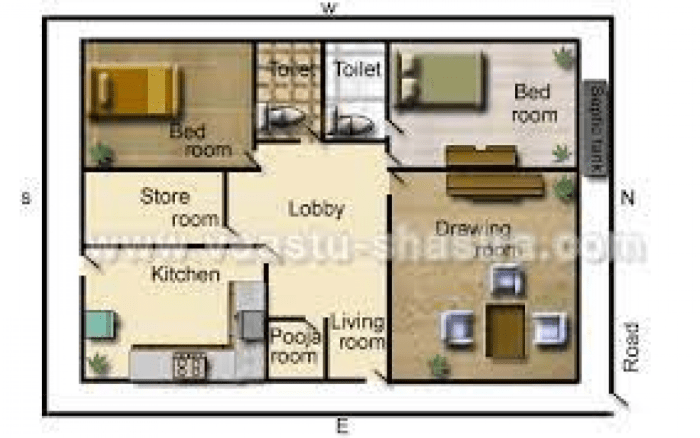Vastu Shastra and Modern House Design

Vastu shastra house design – Vastu Shastra, an ancient Indian system of architecture, emphasizes the harmonious integration of buildings with their natural environment. While its principles originated centuries ago, the challenge lies in seamlessly merging these traditional concepts with the aesthetics and functionalities of modern house designs. This requires a thoughtful approach that respects both ancient wisdom and contemporary architectural trends.
Integrating Vastu Principles into Modern Architecture
The core tenets of Vastu Shastra, such as aligning structures with cardinal directions and optimizing the flow of energy (prana), can be adapted to suit modern architectural styles. However, direct application of every traditional rule might not always be feasible or aesthetically pleasing in contemporary designs. For instance, a traditional Vastu-compliant home might feature a central courtyard, which may not be practical or desirable in a high-density urban setting.
The key is to prioritize the fundamental principles while employing creative solutions to address spatial constraints and aesthetic preferences. Modern architects can achieve this by strategically placing key functional areas according to Vastu guidelines, even within a minimalist or contemporary design framework.
Vastu Shastra principles emphasize harmonious living spaces, aligning building design with natural elements. This holistic approach extends beyond the home itself; consider even the placement of birdhouses, for example, a thoughtfully designed space like the peterson bluebird house design might be incorporated into a garden layout to complement the overall Vastu energy flow. Ultimately, the goal is to create a balanced environment that promotes well-being, encompassing both the human dwelling and its surrounding ecosystem.
Specific Vastu Considerations for Different Rooms

Applying Vastu Shastra principles to individual rooms within a house optimizes the flow of positive energy and enhances the well-being of occupants. Careful consideration of room placement, orientation, and design elements is crucial for creating a harmonious living environment. The following sections detail specific Vastu recommendations for kitchens, bedrooms, and bathrooms.
Vastu-Compliant Kitchen Design
The kitchen, the heart of the home, holds significant importance in Vastu Shastra. Its placement and design directly impact the family’s health, prosperity, and overall well-being. An ideal kitchen is located in the southeast (Agni) direction, aligning with the element of fire. This placement is believed to promote good health and wealth. The stove should be positioned such that the cook faces east or north while cooking.
- Dos: Keep the kitchen clean and organized. Use bright and cheerful colors. Ensure adequate ventilation and natural light. Place the cooking range in the southeast corner. Store grains and provisions in the southwest corner.
Avoid placing the kitchen directly adjacent to the bathroom or toilet.
- Don’ts: Do not place the kitchen in the northeast (Ishaan) direction. Avoid placing the sink directly opposite the stove. Do not place heavy equipment or clutter in the northeast corner. Avoid having beams directly above the cooking area. Do not use dark or dull colors in the kitchen.
Creating a Peaceful and Energizing Bedroom
The bedroom is a sanctuary for rest and rejuvenation. Vastu Shastra emphasizes creating a peaceful and energizing space conducive to sound sleep and positive energy. The ideal location for a bedroom is in the southwest (Nairutya) direction. This direction is associated with stability and grounding. The bed should be positioned to allow the occupants to face east or south while sleeping.
- Recommended Practices: Use soft, calming colors. Keep the bedroom clutter-free and well-ventilated. Avoid placing mirrors directly opposite the bed. Use natural materials and fabrics. Ensure the bedroom is well-lit, ideally with natural light.
Avoid placing electronic devices near the bed.
Proper Placement and Design of Bathrooms and Toilets, Vastu shastra house design
Bathrooms and toilets, while necessary, are considered less auspicious in Vastu Shastra due to their association with impurities. Their placement and design should minimize negative energy flow. The ideal location for a bathroom is in the northwest (Vayavya) direction, although it should never be placed in the northeast (Ishaan) direction. It’s crucial to ensure proper ventilation and to keep the bathroom clean and hygienic.
- Key Considerations: Avoid placing the bathroom directly adjacent to the kitchen or prayer room. Ensure adequate ventilation and natural light. Use light and bright colors. Maintain impeccable hygiene. Avoid placing the toilet directly opposite the main entrance.
FAQ Explained: Vastu Shastra House Design
What are the benefits of following Vastu Shastra in home design?
Vastu Shastra aims to improve the overall well-being of occupants by promoting positive energy flow, reducing stress, and enhancing harmony within the home. Benefits can include improved health, better relationships, and increased prosperity.
Can Vastu Shastra be applied to apartments or existing homes?
Yes, Vastu principles can be adapted to apartments and existing homes. While complete adherence might not always be feasible, many remedies and adjustments can be implemented to mitigate negative energies and enhance positive ones.
Is Vastu Shastra a religion or a superstition?
Vastu Shastra is an ancient architectural system based on the observation of natural laws and their impact on human well-being. It’s not a religion but a set of guidelines rooted in the understanding of environmental energies and their influence on human life.
How much does it cost to consult a Vastu expert?
The cost of consulting a Vastu expert varies depending on location, experience, and the scope of the project. It’s advisable to contact several experts for quotes and to find one that suits your needs and budget.
